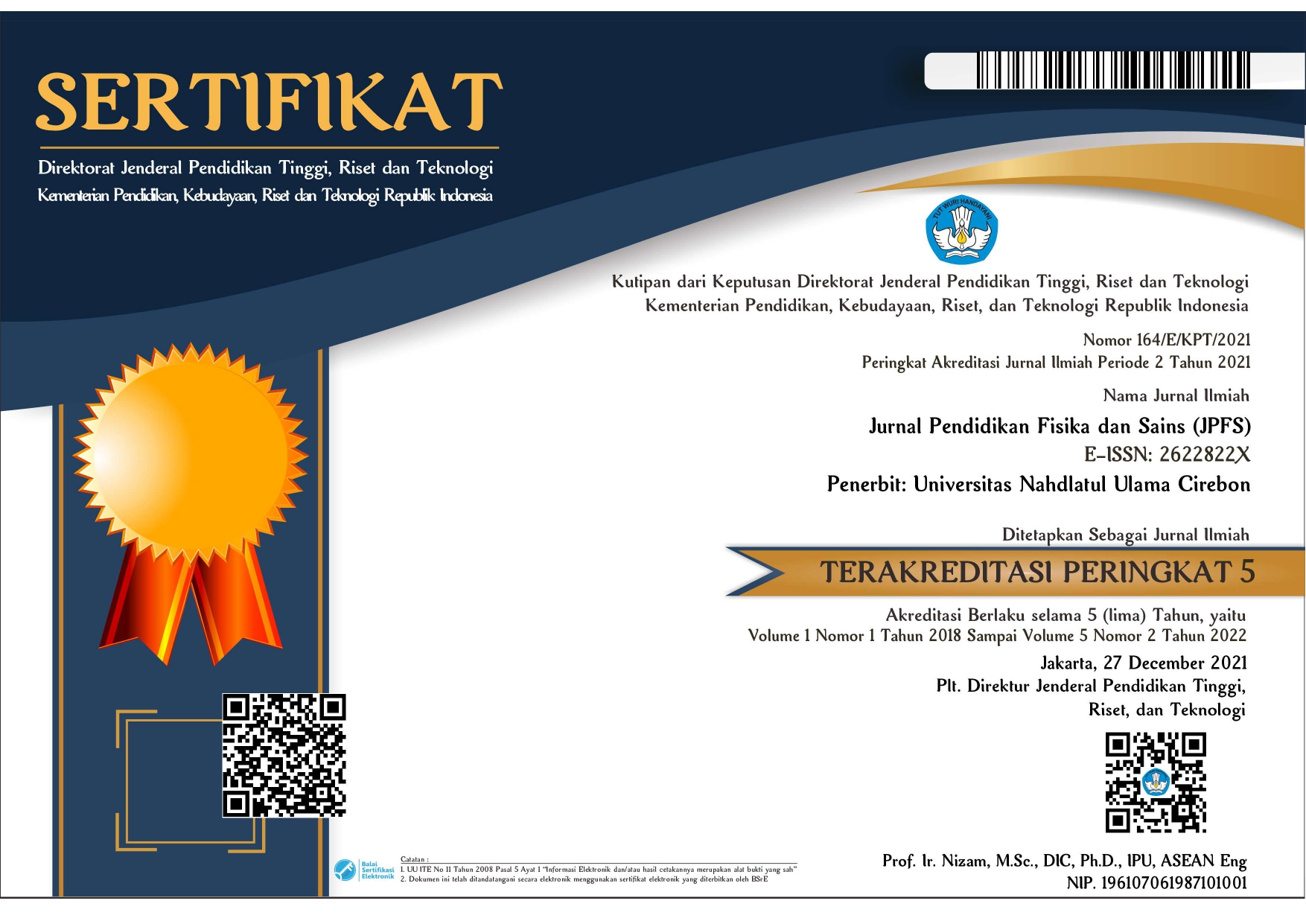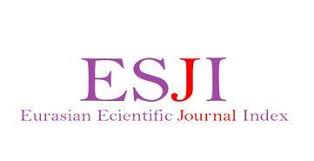Penentuan Konstanta Laju Penurunan Daya Baterai Smartphone Menggunakan Persamaan Kinetika Reaksi Orde Satu
DOI:
https://doi.org/10.52188/jpfs.v6i1.302Keywords:
Daya Baterai, Konstanta Laju Penurunan Daya Baterai, SmartphoneAbstract
Penurunan daya baterai smartphone menjadi sebuah permasalahan tersendiri bagi para pengguna smartphone, dikarenakan belum adanya kepastian waktu pengisian ulang baterai dalam selang waktu tertentu setelah pengisian terakhir kali. Untuk mengatasi permasalahan tersebut digunakan sebuah persamaan kinetika reaksi orde satu untuk memperkirakan penurunan daya baterai berdasarkan nilai konstanta laju penurunan daya baterai ( ). Pada penelitian ini smartphone menjalankan tiga aplikasi secara bergantian yaitu permainan PlayerUnknown’s Battlegrounds (PUBG), Zoom, dan YouTube selama 100 menit untuk diukur penurunan daya baterai. Selanjutnya hasil pengukuran dianalisis menggunakan persamaan kinetika reaksi orde satu sehingga diperoleh nilai konstanta laju penurunan daya baterai ( ) untuk permainan PUBG, Zoom, dan YouTube masing-masing sebesar 0,0022 menit-1, 0,0014 menit-1, dan 0,0011 menit-1. Berdasarkan hasil simulasi, permainan PUBG membutuhkan waktu yang lebih cepat mencapai daya 50% dibandingkan aplikasi Zoom dan YouTube. Selanjutnya, disimpulkan persamaan kinetika reaksi orde satu dapat digunakan untuk memperkirakan kapan smartphone harus diisi ulang sesuai dengan daya minimal baterai yang ditetapkan para pengguna.
References
Bauer, J., O’Mahony, C., Chovan, D., Mulcahy, J., Silien, C.,& Tofali, S.A.M. (2019). Thermal effect of mobile phones on human auricle region. Journal of Thermal Biology, 79, 56-68. https://doi.org/10.1016/j.jtherbio.2018.11.008
Cordella, M., Alfieri, F., Clemm, C., & Berwald, A. (2021). Durability of smartphones: A technical analysis of reliability and repairability aspects. Journal of Cleaner Production, 286, 1–11. https://doi.org/10.1016/j.jclepro.2020.125388
Guo, Y., Wang, C., & Chen, X. (2017). Understanding Application-Battery Interactions on Smartphones: A large-Scale Empirical Study. IEEE Access, 5, 13387–13400. https://doi.org/10.1109/ACCESS.2017.2728620
Haryadi, S., & Syahrillah, G. R. F. (2016). Rancang Bangun Pemanfaatan Panel Surya Sebagai Charger Handphone Di Tempat Umum. Teknik Mesin UNISKA, 02(02), 114–120.
Hustiany, R. (2016). Aplikasi Persamaan Arrhenius dan Linear untuk Pengujian Stabilitas Retensi Impact Compound Flavor Kweni Terenkapsulasi. ZIRAA’AH, 41(3), 393–402.
Javed, A., Shahid, M. A., Sharif, M., & Yasmin, M. (2017). Energy Consumption in Mobile Phones. International Journal of Computer Network and Information Security, 9(12), 18–28. https://doi.org/10.5815/ijcnis.2017.12.03
Kang, S., Choi, H., Park, S., Park, C., Lee, J., Lee, U., & Lee, S.-J. (2019). Fire in Your Hands: Understanding Thermal Behavior of Smartphones. The 25th Annual International Conference on Mobile Computing and Networking (Mo- BiCom ’19), October 21–25, 2019, Los Cabos, Mexico. ACM, New York, NY, USA, 1–16. https://doi.org/10.1145/3300061.3300128
Mariana, E., Wardany, K., & Sari, R. P. (2021). Pelatihan Pemanfaatan Smartphone Android Sebagai Media Pembelajaran Bagi Orang Tua Kelurahan Sidokerto Kecamatan Bumi Ratu Nuban. Indonesia Berdaya, 2, 121–126.
Pramanik, P. K. D., Sinhababu, N., Mukherjee, B., Padmanaban, S., Maity, A., Upadhyaya, B. K., Holm-Nielsen, J. B., & Choudhury, P. (2019). Power Consumption Analysis, Measurement, Management, and Issues: A State-of-the-Art Review of Smartphone Battery and Energy Usage. IEEE Access, 7, 182113–182172. https://doi.org/10.1109/ACCESS.2019.2958684
Santoso, L. I., & Samodrawati, D. (2022). Rancang Bangun Stasiun Pengisian Daya Baterai Smartphone Berbasis Panel Surya. Seminar Nasional TREnD 2, 135–143.
Visuri, A., Hamberg, J., & Peltonen, E. (2022). Exploring the effects of below-freezing temperatures on smartphone usage. Pervasive and Mobile Computing, 79, 1–14. https://doi.org/10.1016/j.pmcj.2021.101509
Yulfa, A. (2014). Aplikasi Monitoring Realtime Kondisi Baterai pada Android. (Skripsi, Universitas Muhammadiyah Surakarta).
Published
How to Cite
Issue
Section
Copyright (c) 2023 Gede Wiratma Jaya, Stevi Silahooy, Sanny Virginia Aponno

This work is licensed under a Creative Commons Attribution 4.0 International License.
Copyright Transfer Agreement
The Authors submitting a manuscript do so on the understanding that if accepted for publication, copyright of the article shall be assigned to Jurnal Pendidikan Fisika dan Sains (JPFS) and Physics Education Programs of UNU Cirebon as publisher of the journal.
Copyright encompasses exclusive rights to reproduce and deliver the article in all form and media, including reprints, photographs, microfilms and any other similar reproductions, as well as translations. The reproduction of any part of this journal, its storage in databases and its transmission by any form or media, such as electronic, electrostatic and mechanical copies, photocopies, recordings, magnetic media, etc. , will be allowed only with a written permission from Jurnal Pendidikan Fisika dan Sains (JPFS) and UNU Cirebon.
Authors are permitted to disseminate published articles by sharing the link/DOI of the article at the journal. Authors are allowed to use their articles for any legal purposes deemed necessary without written permission from the journal with an acknowledgment of initial publication to this journal.
Jurnal Pendidikan Fisika dan Sains (JPFS) and UNU Cirebon and the Editorial Board make every effort to ensure that no wrong or misleading data, opinions or statements be published in the journal. In any way, the contents of the articles and advertisements published in the Jurnal Pendidikan Fisika dan Sains (JPFS) are sole and exclusive responsibility of their respective authors and advertisers.






















